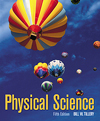|
 |  Physical Science, 5/e Bill Tillery,
Arizona State University
Compounds and Chemical Change
Exercises- Use electron dot symbols in equations to predict the formula of the ionic compound formed from the following:
(a)K and IAnswer
(b)Sr and SAnswer
(c)Na and OAnswer
(d)Al and O Answer - Name the following ionic compounds formed from variable-charge transition elements:
(a)CuSAnswer
(b)Fe2O3Answer
(c)CrOAnswer
(d)PbS Answer - Name the following polyatomic ions:
(a)(OH)-Answer
(b)(SO3)2-Answer
(c)(ClO)-Answer
(d)(NO3)-Answer
(e)(CO3)2-Answer
(f)(ClO4)-Answer - Use the crossover technique to write formulas for the following compounds:
(a)Iron(III) hydroxideAnswer
(b)Lead(II) phosphateAnswer
(c)Zinc carbonateAnswer
(d)Ammonium nitrateAnswer
(e)Potassium hydrogen carbonateAnswer
(f)Potassium sulfite Answer - Write formulas for the following covalent compounds:
(a)Carbon tetrachlorideAnswer
(b)Dihydrogen monoxideAnswer
(c)Manganese dioxideAnswer
(d)Sulfur trioxideAnswer
(e)Dinitrogen pentoxideAnswer
(f)Diarsenic pentasulfide Answer - Name the following covalent compounds:
(a)COAnswer
(b)CO2Answer
(c)CS2Answer
(d)N2OAnswer
(e)P4S3Answer
(f)N2O3Answer - Predict if the bonds formed between the following pairs of elements will be ionic, polar covalent, or nonpolar covalent:
(a)Si and OAnswer
(b)O and OAnswer
(c)H and TeAnswer
(d)C and HAnswer
(e)Li and FAnswer
(f)Ba and S Answer
|
|
|



 2002 McGraw-Hill Higher Education
2002 McGraw-Hill Higher Education

 2002 McGraw-Hill Higher Education
2002 McGraw-Hill Higher Education